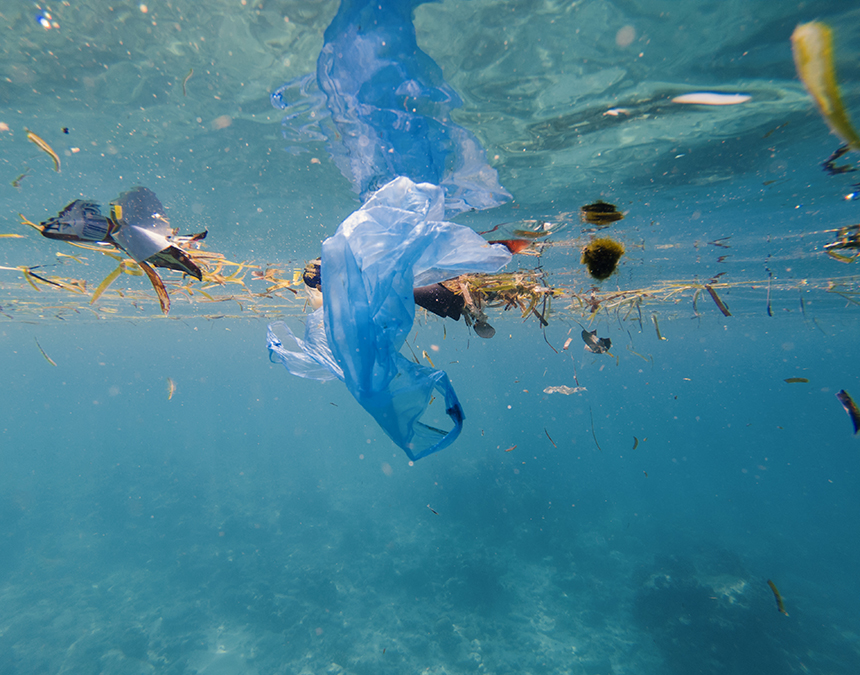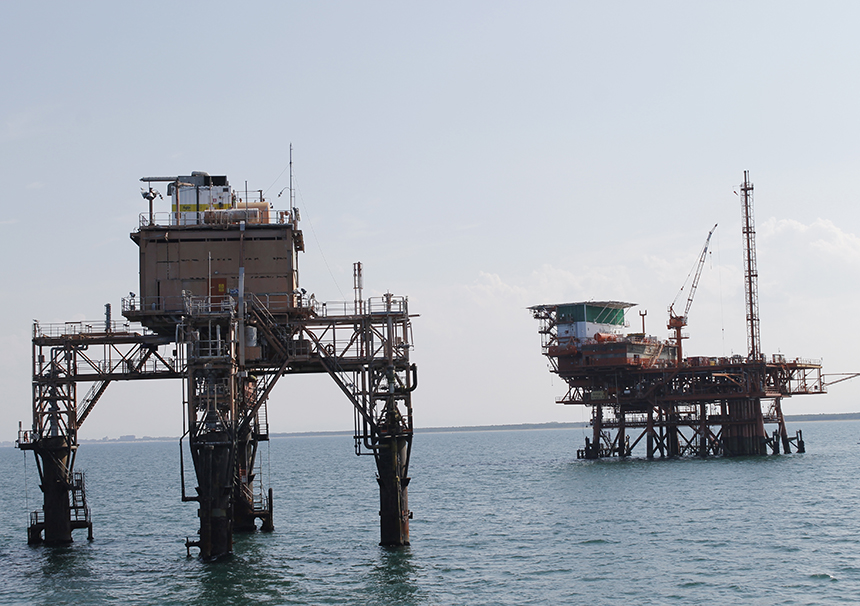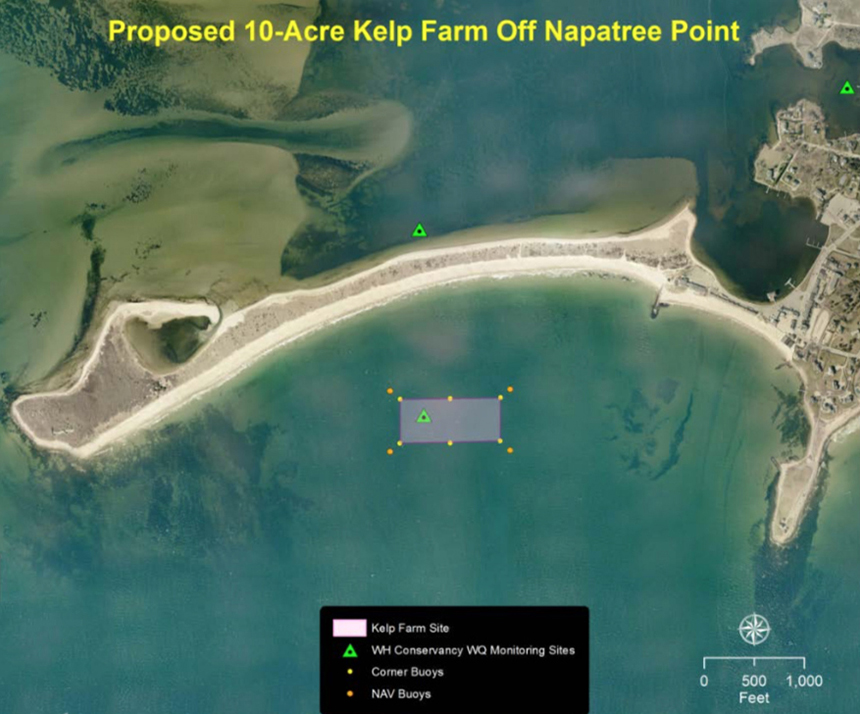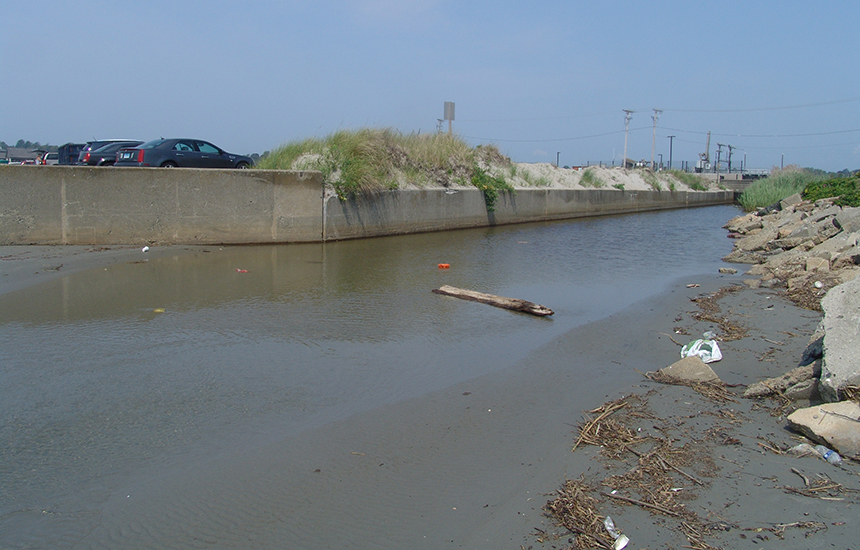Used and Abused: How Much Can the Oceans Take?
Unrelenting pressures and mounting uses in Rhode Island alone highlight stress humans are inflicting upon the marine environment
June 10, 2019
The divergence of ocean uses by human beings is striking. The exploitation of the seas unrelenting. Debate about it polarizing.
A recent proposal to establish a seaweed farm off Napatree Point in Westerly, R.I., is a local example of how divisive ocean use can be.
Joseph MacAndrew, a Westerly resident and chairman of the town’s Conservation Commission, has said his seaweed business venture, which is being backed by out-of-state entities, would serve as an example of a low-impact commercial use of coastal resources.
His plan, however, is facing ample opposition, from academic, business, Napatree Point, and Watch Hill interests.
Opponents claim the proposed sugar kelp farm would obstruct recreational and commercial fishing, disrupt seabird populations, and cause other environmental impacts.
David Beutel, aquaculture coordinator for the Coastal Resources Management Council (CRMC), has expressed little concern about some aspects of the project, referring, for instance, to possible impacts on seabirds, scenic views, and navigation as minimal. But he raised concern about the project’s proposed anchoring system and the potential for genetic contamination by nonnative sugar kelp.
The Rhode Island Department of Environmental Management’s Division of Fish and Wildlife has expressed concern about the project’s potential impact on sea ducks, which are protected under the Migratory Bird Treaty Act.
MacAndrew is seeking a CRMC permit to operate a 10-acre kelp farm some 900 feet south of the Napatree Point Beach & Conservation Area. He has told CRMC that, if done correctly, the operation would enhance the local environment.
Opponents believe otherwise.
As with most issues involving ocean uses, there is pushback and concern.
Questions have been raised about the operation’s potential impacts on recreational and commercial fishing, on kite and wind surfing, on navigation, on the scenic value of Rhode Island’s coast, and on sea ducks, loons, and other seabirds. The project also comes with biosecurity concerns.
The Watch Hill Conservancy, which is dedicated to the conservation of Napatree Point, is among the parties with concerns.
Peter August, a science advisor for the conservancy and a professor of natural resources science at the University of Rhode Island, is against siting the operation off one of southern New England’s most pristine natural barrier spits.
He and The Watch Hill Conservancy have issues with such a facility operating less than 1,000 feet from the shore of a protected conservation area and a globally important bird area, especially for “easily disturbed” sea ducks.
“It’s clearly going to have a number of potential impacts to Napatree Point proper and its viewscape,” August said.
August and Janice Sassi, the conservancy’s steward for Napatree Point, recently met with ecoRI News to discuss the kelp farm proposal and ocean pressures in general.
Sassi is worried that if this kelp farm is OK’d, other aquaculture operations will be proposed and approved for the waters off Napatree Point.
“If it’s allowed in a pristine conservation area, where wouldn’t such an operation be allowed?” she asked. “These first 10 acres will set a precedent.”
Sassi also noted that her concern goes beyond this one kelp farm.
“It just seems like we’re not being thoughtful about how we manage our most precious natural resource,” she said.
Growing uses and mounting pressures are threatening the world’s 321 million cubic miles of salt water. The Ocean State isn’t immune to the accumulating stress. In fact, Rhode Island, like the rest of the world, has plenty to lose. Much has already been lost.
Although ocean waters cover two-thirds of the planet’s surface, this life-sustaining blue liquid is vulnerable to human influences. History, however, clearly shows humans have taken the continued health of this complex ecosystem and the bounty it supplies for granted. How else to explain the use of the world’s five oceans and their countless bays, estuaries, inlets, and coves as dumpsters, toilets, and ashtrays, even as we gorge on cod, quahogs, and calamari and take vacations to ocean swimming destinations.
Biodiversity in the world’s oceans is rapidly declining. We seem think there’s no limit to the abuse the planet’s marine environment can take.

Multiple stressors
Robert Lamb studies how the removal of top predators through extractive fisheries and the alteration of the environment through climate change impact the stability and function of marine ecosystems. He said overfishing and a changing climate are a “double whammy” on ocean health.
“When you’re trying to create a holistic management system for a marine ecosystem that includes fisheries — humans act as another top predator, removing individuals through fisheries,” said Lamb, who was part of the research team that worked on a failed regional conservation effort to make Cashes Ledge in the Gulf of Maine a Marine National Monument. “Think of it like buffalo hunting. These things are not meant to last in the way we use them, in the way we remove biomass, in the way we remove individuals through hunting and fishing. We’re just too good at it. We’re too efficient.”
He rounded out the “big four” ocean stressors with pollution and habitat destruction.
Lamb noted that removing wild kelp — he said millions of tons are harvested annually in Chilean waters alone — and coral damage caused by a number of human activities are destroying the oceans’ most important ecosystems.
The marine ecologist said nitrogen and phosphorous pollution — mainly from agricultural activities but also from golf courses and lawns — is creating dead zones, areas of low oxygen that can kill fish and marine life. Dead zones occur in many areas of the country, particularly along the East Coast and the Gulf of Mexico. In fact, the second-largest dead zone in the world is in the northern Gulf of Mexico.
This dead zone varies in size, but it typically covers an area of 6,000 to 7,000 square miles. Two years ago, National Oceanic and Atmospheric Administration (NOAA) scientists determined that the 2017 Gulf of Mexico dead zone was 8,776 square miles — an area about the size of New Jersey.
Nitrogen and phosphorous overloads, however, aren’t the only pollution troubles impacting besieged marine waters.
“Plastic pollution is a big one,” Lamb said. “They’re finding now microplastics in smaller and smaller and smaller pieces — nanoparticles that are in the guts of shrimp that you can’t even see with a microscope. They don’t disappear. They just get smaller.”

Dumping ground
For more than three centuries, since the Industrial Revolution changed the world economy from agrarian and craftsmanship to one dominated by industry and machines, the ocean has been polluted both intentionally and unintentionally with industrial byproducts, dredged material, sewage sludge, military munitions, and radioactive waste.
For instance, in the 1970s, some 17 million tons of industrial waste was legally dumped into the ocean, according to the MarineBio Conservation Society. In the ’80s, another 8 million or so tons of acids, alkaline waste, scrap metal, coal ash, and other materials were deposited in the ocean.
“Narragansett Bay has probably been subjected to metal pollution longer than any other estuary on the western side of the Atlantic,” the late URI professor Scott Nixon wrote in a 1995 report titled Metal Inputs to Narragansett Bay: A History and Assessment of Recent Conditions. “It seems clear that industries had been quick to take advantage of the expanding sewer system and that waste water from manufacturing made up about one-third of the increasing discharge into Narragansett Bay at Fields Point.”
Nixon’s report noted that on July 8, 1908 the city scow Pomeganset took the first load of sewage sludge down the Providence River into Narragansett Bay and dumped it in deep water south of Prudence Island. This dumpsite was used continuously until 1949. During the 41 years that the Prudence Island dumpsite was used, sludge containing some 137,400 tons of dry solids was released in the middle of the bay.
It’s now illegal to dump industrial waste into the ocean, but the seas are still being inundated with pollution from: stormwater runoff carrying fertilizer, pesticides, animal waste, road salt, oil, and grease; combined sewage overflows; contaminants of emerging concern; plastics; and, of course, illegal dumping.
Humans eat food from and swim in waters our activities have polluted with organohalogen compounds, heavy metals such as cadmium and mercury, crude oil, refined petroleum, cyanide, beryllium, agricultural waste, and pharmaceuticals.
All this contamination reduces marine biodiversity, creates dead zones, and spurs algal blooms that strangle seagrass meadows and kelp beds and close beaches.
Mercury and polychlorinated biphenyls (PCBs) are commonly found in seafood. These chemicals cause birth defects, cancer, and neurological problems.
For the past 14 years, Roger Williams University professor David Taylor and his students have been analyzing mercury levels in bluefish, striped bass, black sea bass, tautog, scup, and summer flounder caught in Narragansett Bay, Rhode Island Sound, and Block Island Sound.
They hope their data is one day used by the Rhode Island Department of Health to update the state’s fish consumption advisories. The RWU effort is aimed at encouraging safe, healthy consumption of popular local fish. Many of the locally caught fish Taylor and his students have tested have exceeded the Environmental Protection Agency’s threshold level for mercury.
Between 1993 and 2003, advisories for PCBs in fish and shellfish increased 177 percent, from 319 to 884, according to the EPA’s National Listing of Fish and Wildlife Advisories.
Researchers have found microplastics in the world’s deepest oceans. Last month, scientists found 238 tons of plastic waste on a remote island in the Indian Ocean. A recent study found the quantity of plastic particles hundreds of meters underwater off California is on par with the Great Pacific Garbage Patch.
Straws, shopping bags, and other single-use plastics account for about 80 percent of the Ocean State’s marine debris, according to a recent Task Force to Tackle Plastics report.
URI oceanography professor Rainer Lohmann, who studies chemical pollutants in the marine environment, has tracked chemical compounds — pesticides, mercury, PCBs, and flame retardants — from Narragansett Bay to the Arctic Ocean. He’s even found them in the mother’s milk of Antarctic fur seals.

Drill, blast and bomb, baby
Late last year the National Marine Fisheries Service issued incidental harassment authorizations to five companies, allowing them to harass marine mammals using seismic airguns as they search for fossil fuels beneath the Atlantic Ocean.
Several East Coast states, including Massachusetts and Connecticut but not Rhode Island, have joined a lawsuit suing the National Marine Fisheries Service, a division of NOAA, for not protecting marine natural resources.
During seismic surveys, ships pull large arrays of airguns that release loud pressurized blasts of air into the seafloor. Noise from airguns can injure and disorientate sea life, from zooplankton at the base of the food web to sea turtles, dolphins, and whales.
Seismic airguns produce loud, repetitive sounds that can travel underwater up to 2,500 miles. Blasts are repeated as often as every 10 seconds for days, weeks, or even months at a time. These airguns create some of the loudest manmade noise in the ocean.
About a third of the oil and gas extracted worldwide comes from offshore sources. But with many of the shallow-water oil and gas fields nearing exhaustion, fossil-fuel corporations have to penetrate greater depths to access hydrocarbon deposits.
More toxic drilling muds and fluids are discharged into the ocean during exploratory drilling, because these wells are generally deeper, drilled slower, and are larger in diameter. Drilling waste, including metal cuttings, from exploratory drilling are generally dumped in the ocean, rather than being brought back up to the platform, according to Oceana.
Offshore drilling for hydrocarbons creates a foul mixture of pollution: brine wastes, drilling muds, metal cuttings, platform runoff, flowline and pipeline leaks, and catastrophic spills and blowouts such as the Deepwater Horizon disaster that spewed 4.9 million barrels of oil into the Gulf of Mexico (and killed 11 people).
Different types of drilling muds are used but all release toxic chemicals. One offshore platform normally drills between 70 and 100 wells and discharges more than 90,000 metric tons of drilling fluids and metal cuttings into the ocean, according to Oceana.
Military training and testing, which often includes the use of both low-frequency and high-frequency sonar, low-level seismic airguns, and explosions, and the construction of offshore wind turbines adds to the cornucopia of manmade underwater noise pollution that stresses sea life.

Acidic water and bleached coral
The oceans absorb about a quarter of the carbon dioxide produced annually from the burning of fossil fuels, and it’s changing their basic chemistry. Seawater absorbs carbon dioxide, turning it into carbonic acid and other chemical byproducts that lower the pH of the water and make it more acidic.
Ocean acidification is bad news for marine life with calcium carbonate in their shells or skeletons, such as corals, crabs, and mollusks. Studies have found that more acidic salt waters make it more difficult for mussels, oysters, and scallops to develop their hardened protection.
Shellfish rely on aragonite, a naturally occurring form of calcium carbonate, to generate their shells. Increased ocean acidity, however, means less aragonite, forcing mollusks to expend more energy to build shells and less on reproduction and survival.
Acidic seawater also makes it more difficult for clownfish to sense predators, for sharks to hunt prey, and for squid to develop, among other impacts.
Scientists have estimated that carbon pollution is causing oceans to acidify faster than they have in 300 million years.
“Rising ocean acidity is now considered to be just as much of a formidable threat to the health of Earth’s environment as the atmospheric climate changes brought on by pumping out greenhouse gases,” according to a 2012 Smithsonian.com story.
A study published in 2015 noted that Rhode Island, Massachusetts, and Connecticut are among 15 states whose shellfish industries are at long-term economic risk from the impact of ocean acidification.
Coral reefs form the most biodiverse habitats in the ocean, and their presence is essential to the survival of thousands of other marine species — many of which humans rely on for food.
But like mollusks, corals need access to calcium in seawater to build their hard skeleton. This need is especially vital in the early stages of a coral polyps’s life, when it settles onto a hard substance and starts building its skeleton. Some studies, however, have shown a 52 percent to 73 percent decline in larval settlement on reefs that are experiencing lower pH levels.
Warming and acidifying waters, though, aren’t the only threats to coral worldwide. Besides being destructive to fish species, cyanide fishing — divers crush cyanide tablets into plastic squirt bottles of seawater and puff the solution to stun and capture live coral reef fish for the marine aquarium trade — also damages coral habitat. Cyanide kills coral polyps and algae, turning many coral reefs into marine deserts and severely limiting their ability to protect coasts from storm surge.
As natural flood barriers, healthy coral reefs save the United States $1.8 billion in annually in property damage, according to a new study.

Fishing and farming
The 1,000-foot-by-430-foot kelp farm proposed off Napatree Point would feature 20 long lines, each one hanging 5 feet deep, and multiple anchors and buoys. The water depth at the site is 20 feet. Kelp is grown 5 feet below the surface, and kelp blades can grow to be 10 feet long.
“There’s going to be a lot of material in the water when kelp is being harvested,” August said.
Kelp farming, like oyster farming, is a growing industry in southern New England. High in nutrients, kelp is grown for human consumption or as cattle feed. It’s also used in toothpaste, pharmaceuticals, and cosmetics. Like oyster and other shellfish farming, the environmental impacts of kelp farming, which absorbs carbon dioxide and helps reduce oceanic acidity, are far less than those linked to commercial fishing and finfish farming.
The diminished environmental impact of aquaculture, however, doesn’t mean there’s little controversy. Like the debate that surrounds the siting of ground-mounted solar panels in Rhode Island and elsewhere, the siting of kelp farms and shellfish farms is all about location.
The impacts associated with catching and raising wild and farmed fish are more significant. When commercial fisheries target a certain fish species, other sea life not intended to be caught, such as marine mammals, sea turtles, and non-targeted fish species, can become entangled in nets and lines. Most of these animals, referred to as bycatch, die.
For example, for every pound of shrimp caught, up to 6 pounds of other species are discarded, according to the Monterey Bay Aquarium.
Bycatch isn’t much of a concern with bottom trawls and dredging, but habitat damage is. Sandy bottoms and rocky environments regenerate fairly quickly after bottom trawl nets or metal rakes pass through, but bottom trawls and dredging for shellfish and bivalves can significantly impact sensitive habitat such as deepwater coral or sponge gardens.
Another problem, Lamb said, is that the industry is “just getting too good” at finding and catching sea life.
“We’re going farther and deeper with our technology to the point where fish have no places left to hide,” the marine scientist said. “At the same time, I don’t want to make it seem like fishermen are the bad guy or the problem. Rather, it’s a global problem that has many actors in it and requires many solutions. We actually work a lot with fishermen … I find they are an underutilized source of knowledge. … They also have a vested interest in the long-term sustainability of fisheries.
“At the end of the day, I think we all want the same thing, but it’s hard to find a common ground.”
Lamb noted that top predators such as bluefin tuna and other large consumers are fished more quickly than they are able to reproduce. For example, he said there are rockfish off the coast of California that live 50 to 100 years but aren’t reproductive until they are 20 or 25. How can a fishery like that persist, he asked?
The member of the Witman Lab at Brown University, said this results in “fishing down the food web.”
“You start off with top predators that are large … tunas and sharks and whales even are caught first because they are the biggest bang for your buck,” he said. “Then you start moving down the food web into snappers and groupers, then you catch all those and all you’re left with is sardines and anchovies and maybe even just a gelatinous mess of sea plankton, sea stars, and anemones and jellyfish. People are catching that kind of stuff off the coast of China and Japan now because there’s nothing else.”
The depletion of smaller forage fish also comes with ecological consequences and can upend entire food webs and the ocean’s very chemistry.
Finfish farms pollute with waste, parasites, disease, antibiotics, and chemicals, which can lead to the death of other sea life, the spread of disease to other species, and the formation of toxic algal blooms.

Polluted playgrounds
Beaches are a critical component of the Ocean State’s recreational and tourism appeal, and beach closures reduce the quality of life for both residents and tourists and hurt the local economy.
For instance, 88 times between 2015 and 2017, or about once every three days during the summer, water sampled at one of Rhode Island’s most popular beaches tested high for fecal matter. While Easton’s Beach was closed only four times in that span, the presence of human pathogens in the Newport beach’s water has long been an issue. This problem, however, isn’t isolated to Aquidneck Island or even Rhode Island.
Fecal pathogens are the leading cause of water-quality impairment nationwide. The EPA has estimated that up to 3.5 million people become ill annually from contact with contaminated recreational waters.
Exposure to harmful microorganisms through swimming, surfing, and boating can cause health problems such as gastroenteritis and sore throats, or even meningitis and encephalitis.
The bacterial pollution of saltwater beaches is often caused by stormwater runoff and overflows from wastewater treatment facilities. Contamination, such as phosphorus- and nitrogen-containing fertilizers, from these sources is magnified by impervious surfaces, highly developed watersheds, and more intense and more frequent precipitation. Septic systems in need of maintenance and cesspools also contribute to the problem.
To deal with this complex problem impacting a sophisticated but fragile environment, human beings need to do a better job reducing the stress put on the world’s oceans and do a better job managing how the marine environment is used. Rhode Islanders should understand that as well as anyone.
“We live in the Ocean State. We’re around it every day,” Lamb said. “People are enjoying their stuffies, going out to the beaches … it’s a moment to reflect on what we are getting from the ocean and what we owe it in return.”
To celebrate World Oceans Day (June 8), the Witman Lab at Brown University produced a video about the importance of ocean health and what we, as a collection of individuals, can do to help protect this complex ecosystem.




You really know your ecology. You’ve summarized the main points from several books on global warming as well as applying them to R.I. I wish I could remember one I read that has a memorable 2 page representation of our mighty enormous oceans circulating around the puny amount of land on our planet.
I hate to say it, but All of the earth’s and ocean problems are due to too many humans. We had about 1 billion in the year 1800 and now look at us! 7 billion and counting. We all need to eat, drink, stay warm, have a place to live, poop, and breathe. The earth can not handle us! We are causing too much waste and destruction. Not to mention our need for weapons and their waste….I wish more would be said about voluntary childlessness, or at least personally choosing to limit how children to have to one or two as a personal sacrifice to help save the future of the earth and humans.
Interesting article and you bring up some valid points about overfishing and the destructiveness of certain aquaculture practices (e.g., fish farming is just plain bad). But, the facts you present have little or nothing to do with ocean farming of native seaweeds and shellfish.
There’ not room here for a lengthy discourse on the data for multitiered ocean farming, but the benefits of this type of aquaculture far outweigh the risks. Gear loss is a potential issue, so siting the farm in the correct location is very important. Also, the fact that local, native seaweeds and shellfish can be spawned and used as seed will have no deleterious effects on wild growing seaweeds. I urge you to get more facts on the subject and not use other forms of destructive farming, aquaculture and overfishing as your source of data for comparison to ocean farming. That is poor reporting and only serves to fuel the uneducated.